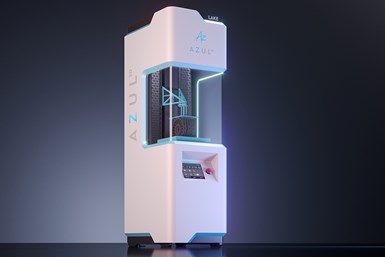Azul 3D’s Lake Printer Offers a Single, Streamlined Production Platform
IMTS 2022: Azul 3D says its Lake printer enables manufacturers to transition from prototyping to mass manufacturing on a single, streamlined production platform.
Share
Read Next
The Lake printer is powered by Azul 3D’s high-area rapid printing (HARP) technology, its version of stereolithographic printing that converts liquid plastic into solid objects using ultraviolet light. Photo Credit: Azul
Azul 3D’s Lake printer was developed to provide continuous printing over large areas with an array of materials, enabling manufacturers of industrial, consumer and automotive goods to easily convert to mass manufacturing on a single, streamlined production platform.
The printer is powered by Azul 3D’s high-area rapid printing (HARP) technology, which is the company’s version of stereolithographic printing that converts liquid plastic into solid objects using ultraviolet light. The company says the printer can prin complex geometries at rapid speeds, using materials suited for a range of products.
With a print area of 10″ × 12” × 24”, the printer’s interface dissipates heat, enabling continuous high-speed printing over large areas. The printer is powered by a custom, high-intensity LED light engine that enables users to address 16 million independent pixels without the need for “pixel shifting” used by other projectors.
The printer is also bolstered by Azul 3D’s chemistry group, which designs proprietary resins that are strong, durable, customizable and compatible with high throughput printing.
Related Content
-
Why This Photopolymer Developer Wants Prototyping to Go “Massless”
High-performance materials supplier polySpectra is embracing augmented reality (AR) with a new tool called Massless intended to reduce unnecessary 3D printing.
-
Bridge Production Is Real Production
Not prototyping — it is something far more than this. The chance to launch the product into the world using additive manufacturing as the initial process delivers important new possibilities, and even keeps on delivering advantages far into the product’s life.
-
3D Printing Enables Mold Shop to Rapidly Prototype Medical Parts (Video)
A case study involving Mantle’s 3D printing technology allowed moldmaker Westminster Tool to go from design to injection molded prototype medical parts in three weeks.










.png;maxWidth=300;quality=90)



